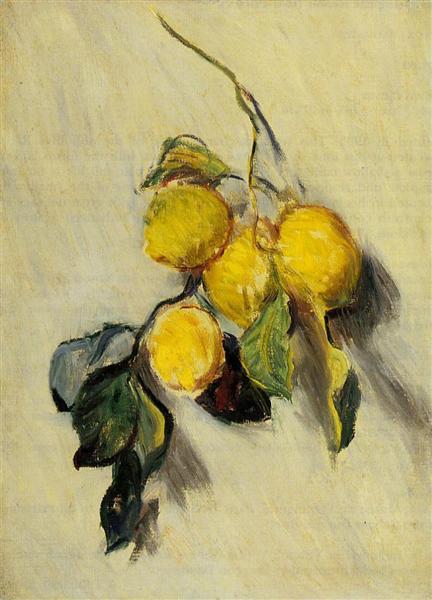Description
Claude Monet's painting "Branch of Lemons", painted in 1883, is one of the works that encapsulates the artist's characteristic approach to nature and his ability to capture light in its different manifestations. This work falls within the painter's mature period, in which the impressionist concerns are reflected in a luminous and vibrant way, making the objects depicted seem almost fleeting and ethereal.
When looking at this work, the first impression is the delicacy and freshness it evokes. Monet focuses on a simple branch of lemons, which hangs against a subtle but effective background. The composition is simple, but achieves a great visual charge thanks to the articulation of color and light, which play a fundamental role in aesthetic perception. The branch occupies a central place, inviting the viewer to appreciate the details of its shape and texture. The lemons, with their warm and vibrant hue, stand out with a particular luminosity that seems to almost transcend the surface of the canvas.
A notable aspect of “Branch of Lemons” is the use of light and its interaction with the objects depicted. Monet demonstrates his mastery in capturing luminosity through loose, light brushstrokes, which create a natural atmosphere. Lemons are not simply fruits; they become emblems of life and freshness. Shadows are used with great subtlety, allowing the bright colors of the work to stand out without losing naturalness and depth. Through these elements, Monet manages to convey the sensory experience of sight, almost making the viewer imagine the fresh scent of citrus.
The colour palette he uses is predominantly yellow and green, two colours that symbolise joy and spring. The yellow not only illustrates the colour of the lemons, but also represents the sunlight filtering through the leaves, providing a sense of warmth. The shades of green add a vital contrast and a sense of natural abundance, elegantly complementing the vibrancy of the lemons. This focus on luminosity and colouration is characteristic of Monet’s work, who cared deeply about the representation of colour as a vehicle for conveying emotions and sensations.
Although "Branch of Lemons" is a work that focuses on an inanimate object and lacks human figures, its essence lies precisely in the celebration of the everyday. Monet, through his impressionist style, turned his gaze towards soft and personal spaces and objects, challenging the conventions of academic art of his time. This work reflects the desire to capture beauty in the simple and the transient, something Monet has done in many of his works, such as in "The Water Lilies" or "Impression, Sunrise."
It is important to mention that Monet developed this painting during a period when he was deeply influenced by his surroundings in Giverny, where he cultivated a garden that would become an endless source of inspiration. His connection with nature is evident in "Branch of Lemons," which encapsulates his appreciation for the ephemeral and beautiful moments of everyday life. This work, although fleeting in its subject matter and execution, stands as a powerful testament to Monet's genius in the depiction of light and color, reaffirming his place in the history of Impressionist art.
Through “Branch of Lemons,” Monet not only offers us a captivating visual image, but also invites us to contemplate the extraordinary in the ordinary, a message that resonates with the spirit of Impressionism as a whole. Within the canvas, despite its apparent simplicity, lies a profound reflection on the passage of time and the ephemeral beauty of nature, elements that continue to fascinate and attract viewers to this day.
KUADROS ©, a famous painting on your wall.
Hand-made oil painting reproductions, with the quality of professional artists and the distinctive seal of KUADROS ©.
Painting reproduction service with satisfaction guarantee. If you are not completely satisfied with the replica of your painting, we will refund 100% of your money.

